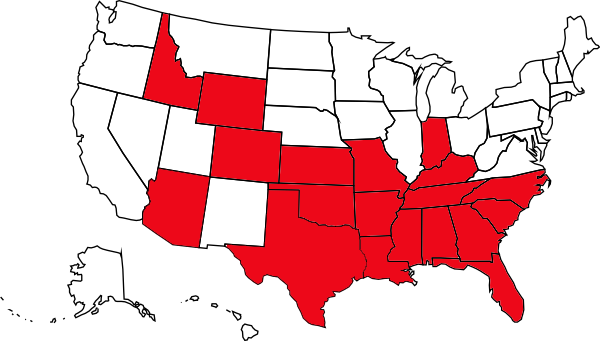Inmates in America’s prisons are protected from corporal punishment, yet it is a system of discipline that still exists in public schools in nineteen states. Teachers and principals are allowed to strike a child, either with a paddle, an open hand, or, in some cases, a ruler, to punish them. Students may be struck on the bottom of the upper thighs. Generally speaking, students are directed to bend over a desk or chair while a school official administers the punishment. For safety purposes, it is usually witnessed by another school official, but sometimes, the punishment is neither discussed nor approved by the child’s parents.
The vast majority of states that still allow these punishments are in the Deep South, where large populations of students of color – especially African Americans – comprise the student bodies of public schools. Texas leads the way with over 10,000 cases of spanking or paddling each year. However, some states in the West, including Wyoming, Idaho, and Arizona, also allow corporal punishment.
While these states still allow corporal punishment, many of their school districts have taken it upon themselves to ban the practice. However, many school districts persist in using spanking and paddling as punishment. In fact, according to the Department of Education, each year, hundreds of thousands of students are subjected to corporal punishment. While some districts in larger, urban schools still employ the practice, it occurs mostly in smaller, rural communities. The Department of Education reports that of these students, an overwhelming majority are male (over 78 percent), and over one-third are African-American. A disproportionate number of disabled children are also subjected to physical punishments at school.

Nineteen states (in red) have laws permitting corporal punishment in schools. Source: The Center for Effective Discipline
Marion County, Florida: A Unique Case
In 2010, officials in Marion County, Florida, banned corporal punishment in their schools after determining that it was an ineffective method of reprimanding students. However, in 2013, the Marion County district’s school board voted to reinstate its use after an annual review of the district’s discipline code found it to be deficient.
The primary reason the school board gave for reinstating corporal punishment was to have a disciplinary option that keeps kids in school rather than resorting to expulsion or suspension, which, according to one school board member, “is like a vacation” for students. The revised policy includes strict provisions for the use of paddling, which is only an option for severe offenses in which children use physical violence against another student, a teacher, or other school personnel. Furthermore, parents can opt their child out of the program, and those who opt in must be called before the punishment is handed down.
Nevertheless, the district’s superintendent sees the school board’s actions as taking a step in the wrong direction and has asked that any principal who plans to discipline a child by paddling contact his office first. The superintendent hails other methods of discipline, namely in-school suspension, and counseling, as much better alternatives to helping children correct negative behaviors.
Why Corporal Punishment?
The Marion County case illustrates both sides of the corporal punishment issue. Supporters insist it is a more effective punishment than expulsion or suspension because students are not removed from class for long periods and can resume learning quickly. This, in turn, reduces the likelihood that a student falls behind in his or her classes and drops out of school altogether.
Because it is a more salient punishment – the physical results are immediate and profound – students may be less apt to break school rules, albeit out of fear. This is true for both the child who committed the offense and his or her classmates who learn of the punishment given. Proponents also maintain that students who exhibit violent or anti-social behavior, such as fighting or bullying, deserve physical punishment because their offenses are violent. Additionally, supporters argue that corporal punishment is more likely to teach a child respect than passive punishments such as expulsion.
In many districts that still allow spanking and paddling, it is also a matter of local control over education. Local officials, parents, and teachers who oppose corporal punishment may oppose state or federal attempts to oversee their school’s discipline policies. Additionally, some supporters of corporal punishment invoke the mantra, “I was hit when I was young and I turned out fine,” as a defense for its continued use.
The Case Against Corporal Punishment
The reasons for ending corporal punishment far outweigh the benefits of the practice. First and foremost, detractors maintain that it is a barbaric custom that serves only to engender violence in young people by teaching them that causing someone else physical pain is okay. Resolving conflict by spanking or otherwise inflicting harm does nothing to teach corrective behaviors or build positive coping strategies for children who act out. Furthermore, physically disciplined children may fail to develop strong bonds with adult authority figures due to a lack of trust. Parents whose children have been subjected to physical punishments at school commonly report this and other mental health-related side effects, including emotional trauma, anxiety, disengagement, and a reluctance to learn.
The physical impacts of corporal punishment also cannot be overlooked. Students who are hit with a paddle – which in some cases can be a modified and flattened version of a baseball bat – can receive cuts, splinters, bruising, and, in some cases, muscle and tissue damage. More serious injuries, including hematomas, whiplash, and hemorrhaging, can also occur. According to the Center for Effective Discipline, some children have even died as a result of the injuries they sustained from school-sanctioned paddling.
Shockingly, despite the negative consequences of corporal punishment, some want to see it remain—and even strengthen—in public schools. In February 2014, a Kansas lawmaker proposed revising the state’s corporal punishment laws to include hitting that leaves redness and bruising. The state’s current law does not permit school personnel to leave a mark. Fortunately, the public outcry was strong enough that the state’s House Corrections and Juvenile Justice Committee will not consider the proposed bill.
Minority Students Punished More Often
As has been widely reported, students of color are suspended more often than their peers, are expelled more often than their peers, and are punished for infractions that white students are not. This unfortunate trend extends to corporal punishment as well. While African-American students comprise just over 17 percent of the national student population, they account for over 35 percent of all students subjected to corporal punishment.
This news report tells why some students are more likely to be victims of corporal punishment than others.
In Mississippi, where corporal punishment is still allowed, and approximately half the student population is African-American, 64 percent of students who are paddled are black. In some Mississippi schools, the paddle comes out for even the most minor infractions: for not finishing one’s homework on time, throwing a crumpled piece of paper away in anger, or wearing the wrong color t-shirt. Despite these shocking misuses of such a harsh disciplinary procedure, paddling has sharply decreased over the last several years. From 2008 to 2012, the number of school-sanctioned uses of the paddle dropped by 33 percent in the state.
The Future of Corporal Punishment
Although there is no federal ban on corporal punishment, the Supreme Court ruled in 1977 in Ingraham v. Wright that it is a state issue, and some in the House of Representatives seek to ban the practice. Two dozen Democrats have proposed a bill that would ban corporal punishment nationwide. To enforce the ban, federal education money would be withheld from states that do not comply to strong-arm them into compliance.
New Jersey was the first state to ban corporal punishment in 1867. However, it wasn’t until the 1970s and 1980s that many states joined in and banned the practice. Nevertheless, it remains a startling fact that in the 21st century, children can still be physically punished by an adult while at school. With or without federal or state laws banning these practices, International Law recognizes corporal punishment, especially in instances in which it is doled out to a child with a disability, as a violation of that child’s fundamental human rights. Corporal punishment is considered a form of torture by the United Nations, which banned its use in the Convention Against Torture Treaty – a document the United States signed and wholeheartedly endorses.
Questions? Contact us on Facebook. @publicschoolreview















